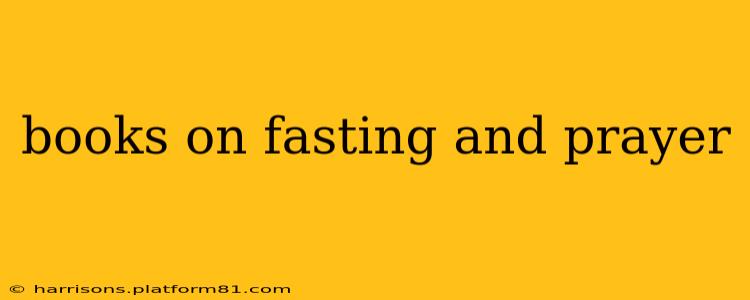Fasting and prayer, two powerful spiritual disciplines practiced across various faiths, offer profound opportunities for spiritual growth, self-reflection, and a deeper connection with the divine. While many resources address each practice individually, fewer explore their synergistic relationship. This article delves into the rich literature available on fasting and prayer, highlighting key titles and themes to help you find the perfect guide for your spiritual journey.
What are the benefits of fasting and prayer?
The benefits of combining fasting and prayer are multifaceted and deeply personal. Fasting can heighten spiritual awareness by creating a space for introspection and focusing the mind. This heightened awareness makes prayer more potent and meaningful, allowing for a more profound connection with the divine. Many find that the physical discipline of fasting mirrors the spiritual discipline of surrendering to a higher power, leading to greater humility and reliance on faith. The experience can foster increased empathy for those facing hunger and suffering, deepening one's compassion and commitment to service.
What are some books that combine fasting and prayer?
Unfortunately, there isn't a vast library specifically dedicated to the combined practice of fasting and prayer. Most books focus on one or the other. However, by understanding the core principles of each, you can effectively utilize resources on each topic to enhance your practice.
Here's a breakdown to help you find relevant resources:
Books on Fasting:
Many books on fasting focus on the physical and spiritual benefits, often referencing prayer as a complementary practice. While not directly combining them, these resources offer valuable insight into the discipline of fasting:
- Books emphasizing the spiritual aspect: Search for titles focusing on "spiritual fasting," "fasting for spiritual growth," or "fasting and spiritual disciplines." These books often explore the theological and experiential aspects of fasting within specific religious contexts. Look for authors who offer a balanced approach, acknowledging both the physical and spiritual dimensions.
- Books focusing on different fasting methods: Understanding the various types of fasts—water fasts, juice fasts, intermittent fasting—is crucial. Many books offer guidance on choosing the right fasting method and managing its physical effects. Combine this knowledge with your spiritual goals to tailor a practice that works for you.
Books on Prayer:
Similarly, a wealth of resources on prayer can be invaluable when approaching a combined practice. While not always explicitly mentioning fasting, they offer crucial insights into cultivating a deeper prayer life:
- Books emphasizing contemplative prayer: These resources often highlight the importance of silence, stillness, and focused attention, elements that are often amplified during periods of fasting.
- Books on different prayer styles: Exploring different styles of prayer, such as Lectio Divina (prayerful reading of scripture), intercessory prayer, or meditative prayer, can enrich your prayer practice and enhance its synergy with fasting.
How can I find a book specifically about fasting and prayer in a particular religion?
To find books focusing on fasting and prayer within a specific religious tradition (e.g., Christian, Islamic, Jewish), use targeted search terms. For instance, try "Christian fasting and prayer," "Islamic fasting and prayer (Ramadan)," or "Jewish fasting and prayer (Yom Kippur)." This will yield more specific results related to the theological and practical aspects within that faith.
What are some common misconceptions about fasting and prayer?
- Misconception: Fasting is solely about deprivation. Reality: Fasting is a discipline designed to cultivate spiritual focus and deepen one's relationship with the divine. The physical discomfort can be a catalyst for spiritual growth.
- Misconception: Fasting and prayer are only for religious extremists. Reality: These practices are accessible to individuals of various spiritual levels and beliefs, offering a pathway to spiritual growth and self-discovery.
- Misconception: More intense fasts are automatically better. Reality: The length and intensity of a fast should align with your physical capabilities and spiritual readiness. Listen to your body and approach the practice with wisdom and discernment.
How do I safely incorporate fasting into my spiritual practice?
Always prioritize your health and well-being. Consult with your doctor, especially if you have underlying health conditions. Start with shorter fasts and gradually increase the duration as you gain experience and confidence. Pay attention to your body's signals and don't hesitate to break a fast if you experience negative symptoms. Hydration is crucial during any fast. Remember, this is a spiritual journey; approach it with grace, patience, and self-compassion.
This exploration provides a starting point for your search for literature on fasting and prayer. By utilizing these strategies and tailoring your research, you can find the resources that best support your spiritual journey. Remember that the most valuable resource is your own experience; allow the process to unfold organically, embracing both the challenges and the blessings along the way.
